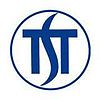University of St. Michael's College
This article needs additional citations for verification. (May 2007) |
 | |
| Motto | Ευσέβεια μουσική γυμναστική |
|---|---|
Motto in English | Goodness, Discipline, Knowledge |
| Type | Federated college of the University of Toronto (1910– present) |
| Established | 15 September 1852 |
Religious affiliation | Catholic Church (Basilian Fathers) |
Academic affiliation | AUCC, TST |
| Endowment | $30.2 million[1] |
| Chancellor | Thomas Christopher Collins |
| President | David Sylvester |
| Principal | Mark McGowan |
| Undergraduates | 4,603[2] |
| Postgraduates | 245 |
| Location | Toronto , Ontario , Canada |
| Campus | Urban |
| Colours | Blue and yellow. Later, green was added. |
| Nickname | Bulldogs, Bay Street Fighting Irish (Historical),"Notre Dame of the North" (Historical) |
| Website | stmikes |
The University of St. Michael's College is a college of the University of Toronto, founded in 1852 by the Congregation of St. Basil of Annonay, France. While mainly an undergraduate college for liberal arts and sciences, St. Michael's retains its Catholic affiliation through its postgraduate theology faculty.
St. Michael's is most closely associated with teaching and research in the humanities and in theology. It is also known for being home to Marshall McLuhan throughout his influential career as a philosopher and communication theorist, from 1946 until his death in 1980. Both the Pontifical Institute of Mediaeval Studies and Metropolitan Andrey Sheptytsky Institute of Eastern Christian Studies reside within the college. St. Michael's College School is an affiliated boys school which was once the high school section of the college.
History[]

St. Michael's College was founded in 1852 as a Basilian college by Pierre Tourvieille, Superior General of the Congregation of St. Basil of Annonay, France.[3] The following year, it merged with St. Mary's Lesser Seminary under the unified control of the Basilian Fathers, whose establishment in Canada began with Bishop Armand-François-Marie de Charbonnel.[4] St. Michael's College educated pupils at three levels, operating as a preparatory school, as a liberal arts college, and as a minor seminary. The Basilians received a large estate in 1853 from John Elmsley, son of the Chief Justice of Upper Canada and a prominent philanthropist. St. Michael's College relocated to the new site east of the University of Toronto, and established the college parish, St. Basil's Church. The incorporation of the college was granted Royal Assent in 1855.[citation needed]
In the late 19th century when universities were closed to new Irish immigrants and many Canadians of Irish descent, St Michael's was seen as the only viable option and thus the school became a traditionally Irish filled college. Ever since this time St Michael's has been a bastion for higher education and a beacon for the Irish-Canadian community in Toronto and southern Ontario, with others coming from all over the rest of Canada to attend the dominantly Irish school.[citation needed]
By withdrawing its financial support in 1868, the provincial government encouraged denominational colleges to seek closer relations with secular institutions. St. Michael's affiliated with the University of Toronto in 1883, having secured a guarantee that it would conduct its own teaching in philosophy and history.[3] The university senate authorized St. Michael's to administer its own examinations in philosophy. On December 8, 1910, St. Michael's College became a federated college of the University of Toronto. The college maintained autonomy in faculty hiring and teaching in liberal arts subjects, while the University of Toronto governed examinations and the granting of degrees in all subjects except theology.[5] In 1912, Sir Robert Falconer, president of the University of Toronto, recognized the wish of St. Joseph's College and Loretto College to affiliate with the university. St. Joseph's and Loretto both became colleges of St. Michael's College, thereby allowing their female students to receive University of Toronto degrees.[citation needed]

As the 20th century began, professional education expanded beyond the traditional fields of theology, law and medicine. Graduate training based on the German-inspired American model of specialized course work and the completion of a research thesis was introduced.[5] With the opening of the Institute of Mediaeval Studies in 1929, St Michael's expanded further into graduate teaching and research. Ten years later, Pope Pius XII signed a papal charter creating the Pontifical Institute of Mediaeval Studies.[6]
The preparatory school division of the college was reorganized in 1950 as St. Michael's College School, an independent private school, ending the college's direct governance while maintaining its affiliation. In 1952, the last lectures for women were held at Loretto and St. Joseph's Colleges, which became residential units of the college. Thereafter, all teaching was conducted coeducationally in the classrooms of St. Michael's College.[citation needed]

Throughout much of its history, St. Michael's benefited from a common practice whereby staff and faculty who were members of religious orders would donate their salaries back to the college. This source of income gradually disappeared as new faculty members were hired with mainly secular backgrounds, compelling the college to seek new revenue. The college's first modern fundraising attempt was launched in 1927, but was only partly successful due to the onset of the Great Depression. The Basilian Fathers of St. Michael's College was registered as a charitable organization in 1972.[7] Subsequent campaigns and land sales allowed the college to gradually increase its endowment, expand its academic programs and construct new residence buildings. The Canadian Catholic Bioethics Institute became affiliated with St. Michael's College in 2001. In 2002, the college marked the sesquicentennial of its founding with an anniversary mass held in St. Basil's Church.[citation needed]
Campus and buildings[]
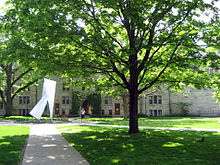
The oldest buildings of St. Michael's College were constructed on the original Clover Hill estate donated by John Elmsley, and were designed by noted Scottish architect William Hay. With subsequent land acquisitions in 1890, 1920, 1926 and 1928, the college expanded from Clover Hill westward to reach Queen's Park. The present grounds of St. Michael's College form the eastern end of the University of Toronto campus, with Victoria College to the north and Regis College to the south. The main quadrangle of St. Michael's College is in the northwestern section of the college grounds, with its northern side leading into Victoria College.
The cornerstone was laid at Clover Hill on September 16, 1855, for the college building and the college parish of St. Basil's Church, which was consecrated November 16, 1856 with a Pontifical High Mass.[8] This building is the oldest building at the University of Toronto in continuous academic use. A further addition, designed by William Irving, was constructed between 1872 and 1873 to house an auditorium, classrooms and student residence. In 1996, the original building was completely renovated by Carlos Ott Partnership Architects and renamed Odette Hall, and a modern religious art gallery donated by Rev. was installed on the two lower floors.

The master plan and Collegiate Gothic complex of buildings at the western side of the college nearest to Queen's Park were built in 1935 and designed by architect Arthur William Holmes in Gothic revival style: the Pontifical Institute, More House, Fisher House, Brennan Hall (1938) and Teefy Hall (1935-6) and extension of the East Wing, (1902–03). Brennan Hall in the north-central section of campus contains a dining hall, faculty dining room, common rooms, and guestrooms.[9]
Fisher House and More House both began as residences for men, while classrooms and faculty offices were located in Teefy Hall to the south. The Queen's Park Building to the north was built for the Pontifical Institute of Mediaeval Studies. A student-faculty centre was built in 1968 as an extension of Brennan Hall.
The Soldier's Memorial Slype connects the college quadrangle with Queen's Park, its sandstone walls etched with the names of St. Michael's College alumni who died in the World Wars and the Korean War.[10]
Examples of early post-war architecture at the college include Carr Hall, designed by Ernest Cormier and built in 1954, housing faculty and administrative offices, classrooms and an auditorium. At the northern edge of campus, Elmsley Hall was built in 1955 as a men's residence and a new residence for the Loretto College was built in 1958. The brutalist concrete building of the John M. Kelly Library was opened in 1969, at the southern portion of the college on St. Joseph Street. The former Ontario Research Council building next to the library has been redesigned with classrooms and offices as the Muzzo Family Alumni Hall.
A private tree-lined street, named Elmsley Place, runs up the center of the college's campus, connecting St Joseph Street to Brennan Hall. This street, laid out around the turn of the 20th century, is flanked by a group of five beautiful brick Victorian mansions that constituted Toronto's first subdivision. On the west side of Elmsley Place, heading south to north, stands McCorkell and Sullivan House (also known as Houses 2 and 96), and Gilson and Maritian House (also known as Houses 6 and 8). Both are student residences. On the east side of Elmsley Place, heading south to north, are Founders House, Phelan House, and Windle House. Founders House, at one point a student residence known as Bellisle House, is currently home to the office of the college's president, as well as other administrative offices. Phalen House serves as the rectory for the Basilian priests who oversee neighboring St. Basil's parish. Windle House, at the northeast corner of the street, is home to the Metropolitan Andrey Sheptytsky Institute of Eastern Christian Studies.
Academics[]
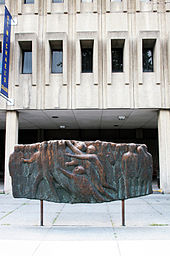
The University of St. Michael's College comprises the Faculty of Theology, the Division of Continuing Education, and its namesake undergraduate division, St Michael's College. Within the University of Toronto Faculty of Arts and Science, St. Michael's College sponsors the academic programs of book and media studies, Celtic studies, Christianity and Culture, Mediaeval studies and the Concurrent Teacher Religious Education Program. In 1996, the French and German departments of the University of Toronto took up residence on the St Michael's campus, followed in 2000 by the departments of Italian and Slavic studies.
After a reorganization in 1954, degrees in theology have been through the Faculty of Theology of St. Michael's College. In 1969, the Faculty of Theology became one of the founding colleges of the Toronto School of Theology, an ecumenical federation of the theological colleges at the University of Toronto.[11] The undergraduate division of St. Michael's College joined the undergraduate divisions of six other University of Toronto colleges in 1974 to reorganize its academic departments into the University of Toronto Faculty of Arts and Science.[5] In 2005, the Pontifical Institute of Mediaeval Studies ceased to be a division of the University of St. Michael's College and was reconstituted as an affiliated institution of U.S.M.C. instead.[12]


Marshall McLuhan was hired as a member of faculty at St. Michael's College in 1946, and taught English literature at the college until his death in 1980. During this time he became famous and influential for his books The Mechanical Bride (1951), The Gutenberg Galaxy (1962), and Understanding Media (1964), in addition to his oft-quoted aphorisms on communications and media such as "the medium is the message".[citation needed]
The John M. Kelly Library is the main library at St. Michael's College, and is part of the University of Toronto's mass digitization partnership with the Internet Archive. Although the library building was opened in 1969, the library collection dates back to the earliest days of the college. The collection has since been developed in support of undergraduate programmes in the Faculty of Arts and Science, graduate programmes in the Faculty of Theology, and programmes of the college's continuing education division. In addition to more than 300,000 bookform volumes, the library maintains subscriptions to almost 500 journals and magazines and has the largest suite of public computers on the east side of the University of Toronto campus.[citation needed]
The Kelly Library's collection has representation mainly in the areas of humanities and social sciences, particularly in book history, media studies, philosophy, Celtic history, languages and literature, Canadian history, English literature, and Medieval history. The theological collection emphasizes patristics, early and medieval church history, Thomism, the Bible (especially Canon, Johannine literature, and the history of criticism), liturgical renewal, religious education, and Catholic missions. There are also extensive archival special collections including substantial holdings of G. K. Chesterton, John Henry Newman, early printed books, and the papers of Henri Nouwen and Sheila Watson.
College Governance[]
Since St Michael's College's founding in 1852, the school has retained a strong connection to its Roman Catholic roots, in particular, with the Congregation of St. Basil. The college is primarily governed by three offices- the Chancellor, the President, and the Principal. The Chancellor serves as the ceremonial head of the college, and since the days of the college's founding, the office has been occupied by the Roman Catholic Archbishop of Toronto. Prior to 1954, the office of the President was referred to as the Superior, and was always occupied by one of the Basilian priests from the adjacent St Basil's parish. The position morphed into the current Presidential role once St Michael's federated into the University of Toronto and re-organized in the 1950s, although several Basilians still held the office following. Today the President heads the administration of the college, and represents its interests in relation to the rest of the university and beyond. Founded in 1976, the office of the Principal heads the college's academics, and retains relations with all the various faculties and departments associated with and located at the college.
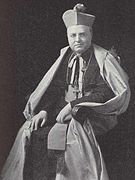
Cardinal McGuigan
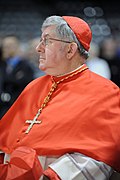
Cardinal Collins

Randy Boyagoda
|
Chancellors of St Michael's College
|
Superiors and Presidents of St Michael's College
|
Principals of St Michael's College
|
Residences and student life[]

This section possibly contains original research. (January 2021) |
Within the secular environment of the University of Toronto, the Catholic traditions of St. Michael's are still evident in its college programs, fellows' interests, and student activities.[citation needed] Thus far, the college has largely avoided stirring controversy in its move toward coeducational residences.

Unlike the coeducational residences at other colleges of the university, male and female students at St. Michael's primarily reside on different floors of the residences, with currently only two mixed-gendered floors. Women students may choose to live at the single-sex Loretto College residence; men are permitted to visit Loretto during designated guest hours.[citation needed]
The dons at St. Michael's College are graduate, senior undergraduate and professional faculty students. The college's dining hall, the Canada Room, has recently been expanded and renovated and its hours have been extended.
Within the college, The Dean’s Office is responsible for residence operations, residence programming and all aspects of student life at St. Michael’s College.
The residences for St. Michael's students are Elmsley Hall Residence (Elmsley First, Mallon House, McBrady House, and Soulerin House), The Queen's Park Residence (Fisher House, More House, and Teefy House), the Historic Houses (formerly named as McCorkell House, Sullivan House, Gilson House, and Maritain House), and Sorbara Hall Residence (Lower Level, Murphy First (unofficial name), Second Floor, Fontbonne House, and Wall House).
Elmsley Hall was renovated in the summer of 2020, making it the most recently renovated space on campus. Renovations included painting and flooring in residence rooms, new furniture and updated common rooms on all floors.
Ice hockey at the college[]
St. Michael's College formerly participated in the senior ice hockey division of the Ontario Hockey Association, and won the J. Ross Robertson Cup in 1909 and 1910.[13]
The Toronto St. Michael's Majors in the Ontario Hockey League descended from the college's ice hockey team.[citation needed]
Notable people[]

Marshall McLuhan

Charles Coughlin

Paul Martin
Laurier LaPierre

Robert J. Birgeneau

J. Michael Miller

Jean Vanier

Bertram Windle

Jacques Maritain
Faculty[]
- William Allen, lawyer and Chairman of the Metro Toronto Council (1962-1969)
- Richard Alway, administrator and educator
- Gregory Baum, theologian, peritus at Vatican II
- Robert Birgeneau, 9th chancellor of the University of California, Berkeley, 14th president of the University of Toronto
- Randy Boyagoda, author and professor
- Father Henry Carr, noted Catholic educator and early administrator of St Michael's College
- , philosopher and professor of Slavic studies
- Maurice De Wulf, professor of philosophy and theology
- Fr. Daniel Donovan, professor of theology and notable art collector
- Ann Dooley, professor of Irish literature and Celtic studies
- Peter Galadza, Ukrainian-Greco Catholic priest, liturgist, and director of the Metropolitan Andrey Sheptytsky Institute of Eastern Christian Studies
- Étienne Gilson, philosopher and historian
- , professor of philosophy and German
- Mark Kingwell, philosopher and professor at the University of Toronto
- Christina Kramer, professor of Balkan and Slavic languages and literature
- Michael Lynch, professor of American literature and prominent gay activist
- Jacques Maritain, philosopher
- Marshall McLuhan, professor of English literature and prominent media critic
- David Mulroney, diplomat and national foreign policy advisor, Canadian Ambassador to China (2009-2012). Also an alumnus of St Michael's College
- Denis O'Connor, Archbishop of Toronto (1899-1908) and college administrator. Also an alumnus of St Michael's College
- Margaret O'Gara, theologian and ecumenist
- Thomas Pangle, political theorist
- Fr. Walter Principe, C.S.B., First Dean of Theology, member of International Theological Commission
- Yves Roberge, professor of French
- Anna Shternshis, professor of Yiddish and German
- Fr. Jean-Mathieu Soulerin, C.S.B., professor and early administrator of St Michael's College
- Kevin Sullivan, filmmaker[citation needed]
- David Sylvester (medievalist), historian and president of St Michael's College
- Emoke Szathmary, 10th president of the University of Manitoba
- Fr. John R. Teefy, C.S.B., president of St Michael's College, journalist, and first editor of The Catholic Register
- Jean Vanier, professor of theology and philosophy, founder of L'Arche
- Paul Weiler, professor of law at Harvard University
- Sir Bertram Windle, biologist, archeologist, and professor
Alumni[]
Academia and Education
- Andrew Carnie, scholar of Celtic languages and professor at the University of Arizona
- Colleen Hanycz, president of La Salle University
- Hugh Kenner, literary scholar and academic
- John S. Kloppenborg, theologian and academic
- Eugene Carlisle LeBel, notable academic and religious leader
- Fr. Thomas Looney, C.S.C., president of King's College
- Douglas Moggach, philosopher and professor at the University of Ottawa
- A. James Reimer, Mennonite theologian and academic
- Daniel James Sullivan, professor, author of An Introduction to Philosophy (1957), and recipient of Purple Heart[14]
- Emőke Szathmáry, anthropologist and president of the University of Manitoba
- Peggy R. Williams, president of Ithaca College
Arts, Literature, and Media
- Bert Archer, journalist and author
- Barry Callaghan, author and poet
- Anne Carson, noted poet, author, and literary scholar
- Rev. Charles Coughlin, controversial radio commentator and harsh critic of Franklin D. Roosevelt[15]
- Kevin Collins, actor
- Charles Foran, author and novelist
- Hugh Hood, author
- Daniel McCarthy, children's television producer who helped create The Friendly Giant, Mr. Dressup, and Sesame Park[16]
- Kevin Sylvester, author, illustrator, and sportscaster
- Sheila Watson, author and literary scholar
- George Weigel, author and political commentator
Athletics
- Marie-Thérèse Armentero, swimmer at the 1984 and 1988 Olympics, bronze medalist at the 1986 World Aquatics Championships
- Bobby Bauer, Hockey Hall of Famer, Olympian, and long time player for the Boston Bruins
- Father David Bauer, Basilian priest, founder of the Canada men's national ice hockey team and inductee into the Hockey Hall of Fame[17]
- Dan D'Alvise, professional hockey player and member of Canadian Olympic hockey team (1980)
- Frank Dunlap, lawyer and professional Canadian football player
- Lori Dupuis, professional hockey player and Olympic gold medalist
- Alan Pyle, member of Canadian Olympic water polo team (1972)
- Dorota Urbaniak, rower and Olympic bronze medalist
- Stelio Zupancich, professional hockey player and member of Canadian Olympic hockey team (1980)
Business
- F. Anthony Comper, president and chief executive of the Bank of Montreal
Government and Politics
- Stella Ambler, member of Parliament (2011-2015)
- Bob Callahan, member of the Legislative Assembly of Ontario (1985-1995) and Brampton City Council (1969-1985, 1997-2014)
- Bonnie Crombie, Mayor of Mississauga (2014–present)
- Leona Dombrowsky, member of the Legislative Assembly of Ontario (1999-2011)
- James Gervase Foley, civil servant and Clerk of the Crown in Chancery for Canada (1908-1914)
- James Joseph Foy, lawyer and member of the Legislative Assembly of Ontario (1898-1916)
- Eugene Pierce Gillespie, member of the United States House of Representatives (1891-1893)
- Barbara Greene, politician and member of Parliament (1988-1993)
- Laurier LaPierre, historian and Senator from Ontario (2001-2004)
- Paul Martin Sr., diplomat and member of Parliament (1935-1974)
- Paul Martin, 21st Prime Minister of Canada (2003-2006)
- David Mulroney, diplomat and national foreign policy advisor, Canadian Ambassador to China (2009-2012). Also served as president of St Michael's College
- Thomas Mulvey, diplomat and Under-Secretary of State for Canada (1909-1933)
- John Raymond O'Neill, member of Parliament (1925-1926)
- Gordon Osbaldeston, civil servant and government administrator
- Edmond Proulx, lawyer and member of Parliament (1904-1921) and member of the Legislative Assembly of Ontario (1923-1929)
- Ian Scott, lawyer and member of the Legislative Assembly of Ontario (1985-1992)
- Greg Sorbara, member of the Legislative Assembly of Ontario (1985-1995, 2001-2012)
- Elizabeth Joan Smith, politician, Solicitor General of Ontario, and member of the Legislative Assembly of Ontario (1985-1990)
- Jim Wilson, politician and member of the Legislative Assembly of Ontario (1990–present)
Health and Medicine
- Dr. Andy Smith, president and CEO of Sunnybrook Health Sciences Centre and professor of surgery at the University of Toronto Faculty of Medicine
Law and Judicial Figures
- John Joseph Dowlin, judge on the Ontario Superior Court of Justice for Kent County, Ontario (1904)
- Louis Martin Hays, judge on the regional court of Wellington County, Ontario, and a major in the 57th Regiment of the 2nd/10th Dragoons (1907)
- Patrick McCurry, judge on the regional court of the Parry Sound District of Ontario (1898)
- Michael Andrew McHugh, judge on the regional court of Essex County, Ontario (1891)
Religious Figures
- Bryan Bayda, Bishop of the Ukrainian Catholic Eparchy of Saskatoon (2008–present)
- David Frederick Cunningham, Bishop of Syracuse (1970-1976)
- Celestine Damiano, Apostolic Nuncio to South Africa (1952-1960) and Bishop of Camden (1960-1967)
- Thomas Joseph Dowling, Bishop of Peterborough (1886-1889) and Bishop of Hamilton (1889-1924)
- George Flahiff, Roman Catholic Cardinal and Archbishop of Winnipeg (1961-1982)
- Richard Grecco, Bishop of Charlottetown (2009-2021)
- Fr. William Richard Harris, Roman Catholic priest, Church historian, Dean of the Roman Catholic Diocese of Saint Catharines
- Brian Kolodiejchuk, Roman Catholic priest and advocate for the canonization of St Mother Teresa
- Michael Pearse Lacey, auxiliary Bishop of Toronto (1979-1993)
- Fergus McEvay, Archbishop of Toronto (1908-1911)
- J. Michael Miller, current Archbishop of Vancouver (2009–present)
- Kenneth Nowakowski, Bishop of the Ukrainian Catholic Eparchy of the Holy Family of London (2020–present)
- Denis O'Connor, first Canadian-born Archbishop of Toronto (1899-1908). Also taught at the University of St Michael's College
- David Joseph Scollard, Bishop of Sault Sainte Marie (1904-1934)
- Michael Joseph Spratt, Archbishop of Kingston (1911-1938)
Further reading[]
- Friedland, Martin L. The University of Toronto: A History. University of Toronto Press, 2002.
- McCorkell, Edmund J. Memoirs of Rev. E.J. McCorkell, C.S.B. Basilian Press, 1975.
- Shook, Laurence K. Catholic Post-Secondary Education in English-Speaking Canada: A History. University of Toronto Press, 1971
- Slater, John G. Minerva's Aviary: Philosophy at Toronto. University of Toronto Press, 2005.
References[]
- ^ "CAUBO 2006-2007 Financial Information of Universities and Colleges" (PDF). Canadian Association of University Business Officers. 2008.[dead link]
- ^ Liang, Xuelun (2018). University of Toronto Facts and Figures (PDF). Toronto: Office of Planning & Budget. p. 33.
- ^ Jump up to: a b St. Michael's College from Ontario Heritage Trust Archived July 16, 2011, at the Wayback Machine
- ^ Pound, Richard W. (2005). Fitzhenry and Whiteside Book of Canadian Facts and Dates. Fitzhenry and Whiteside.
- ^ Jump up to: a b c University from The Canadian Encyclopedia, retrieved 16 January 2015
- ^ "Image of the Historical Plaque outside of the Pontifical Institute of Mediaeval Studies".
- ^ Charities Database from Canada Revenue Agency, retrieved 16 January 2015
- ^ Laurence K. Shook C.S.B. "The Coming of the Basilians to Assumption College Early Expansion of St. Michael's College". Retrieved 22 June 2021.
- ^ Arthur William Holmes from Biographical Dictionary of Architects in Canada 1800-1950, retrieved 16 January 2015
- ^ "World Wars and Korean War memorial: St Michael's College: Memorial 35090-002 Toronto, ON". National Inventory of Canadian Military Memorials. Veterans Affairs Canada. Retrieved 30 December 2016.
- ^ University of Toronto from The Canadian Encyclopedia, retrieved 16 January 2015
- ^ University of St. Michael’s College Act, 2005, S.O. 2005 from ServiceOntario, 15 December 2005, retrieved January 2015
- ^ "Senior Series". Ontario Hockey Association. 2019. Retrieved February 1, 2021.
- ^ Daniel James Sullivan from Geni.com, retrieved 16 January 2015
- ^ "Charles E. Coughlin". www.ushmm.org. Retrieved 12 April 2018.
- ^ "Friendly Giant producer Daniel McCarthy dies". CBC News. 2013-01-18. Retrieved 2013-02-02.
- ^ Oliver, Greg (2017). Father Bauer and the Great Experiment: The Genesis of Canadian Olympic Hockey. Toronto, Ontario: ECW Press. p. 46. ISBN 978-1-77041-249-1.
External links[]
| Wikimedia Commons has media related to University of St. Michael's College. |
- Colleges of the University of Toronto
- Catholic universities and colleges in Canada
- Educational institutions established in 1852
- Catholic Church in Ontario
- 1852 establishments in Canada
























